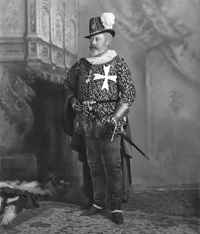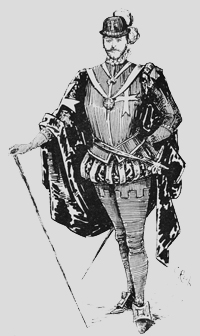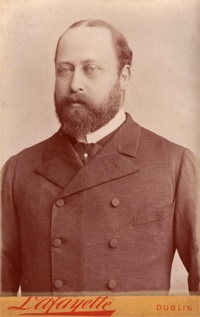Edward, Prince of Wales,
Albert Edward (Bertie), as he was known until he succeeded to the throne, in 1897 was in the unfortunate position of being 56 and still prevented by his mother, Queen Victoria, from playing any role in state affairs. She initially held the shock and horror felt upon the discovery of his romance with an Irish actress in 1861 responsible for the death of her beloved husband Prince Consort. She despised the fast life led by her son and his friends in the “Marlborough House set”, which was named after Edward’s residence in London. For all the misgivings expressed about his capabilities and morals by the press upon his accession, he proved to be not only a popular, but also a dutiful and wise monarch. The Prince’s costume as Grand Master of the Knights Hospitallers of Malta, was made by the theatrical costumier, Monsieur Alias of Soho Square. His wig, made by Mr. Clarkson, was reputed to be “the lightest ever made, weighing barely half an ounce.” Much less elaborate than some of the other guest’s costumes, the prestige of the Prince of Wales meant that almost all of the many published reports described his clothing in minute detail way beyond the ken of even a hardy society reporter - and in such similar terms that this presupposes a printed description handed out by Monsieur Alias. The Daily Telegraph contained one of the more detailed accounts:
The image was registered for copyright with a much simpler accompanying description “Photograph from life of H.R.H. Prince of Wales, full length standing, in fancy costume, left hand on hilt of sword.” The Templars would have been familiar to Edward’s contemporaries from the Sir Walter Scott’s 1819 novel Ivanhoe and Sir Arthur Sullivan’s grand opera of the same name - at whose first performance in 1891 the Prince of Wales was present. As the royal pair were the last to arrive at the Ball, and were then shown to a dais from which they observed the various processions of guests entering the saloon of Devonshire House, this image must have been made in the photographer’s tent in the small hours of the morning – well after the Prince’s favourite bedtime of half-past midnight.
|
Click on image to enlarge  V&A Lafayette Archive V&A Lafayette ArchiveNegative number: L1335 03-07-1897
|
||||
|


